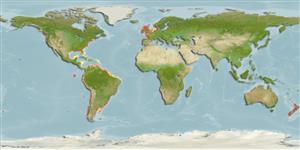Common names from other countries
Classification / Names / Names
Namen | Synonyme | Catalog of Fishes (gen., sp.) | ITIS | CoL | WoRMS
Environment: milieu / climate zone / depth range / distribution range
Ökologie
; tiefenbereich 0 - 30 m (Ref. 87801). Tropical; 62°N - 45°S, 137°W - 177°E
Atlantic Ocean, Pacific Ocean, Mediterranean and the Black Sea. Introduced in Australia and southwest Atlantic.
Length at first maturity / Size / Gewicht / Alter
Maturity: Lm ? range ? - ? cm
This suspension feeder is found on algae, hard and soft bottoms at depths of 0 to 30 m, and even on floating structures like aquaculture installations (Ref. 87801). Found on rock pools (Ref. 124789).
Life cycle and mating behavior
Geschlechtsreife | Fortpflanzung | Ablaichen | Eier | Fecundity | Larven
Members of the order Amphipoda are gonochoric and sexually dimoprhic (males larger than females). Mating behavior: Males locate potential partners with the aid of their antenna to detect the pheromones released by the females; the male then rides or carries the female until the latter is ready to molt. When the female is ready, the male pushes the sperm into the marsupium and releases the female afterwards. A few hours later, the female releases her eggs into the marsupium for fertilization. Life cycle: Eggs are brooded in the marsupium. Eggs hatch into juveniles and remain in the marsupium for a few days. Each species undergo 20 molts at most, i.e., 1-year long life cycle.
Häussermann, V. and G. Försterra. 2009. (Ref. 87801)
IUCN Rote Liste Status (Ref. 130435)
CITES Status (Ref. 108899)
Not Evaluated
Not Evaluated
Nutzung durch Menschen
| FishSource |
Tools
Mehr Information
Alter/Größe
Wachstum
Länge-Gewicht
Länge-Länge
Morphologie
Larven
Dichte
Internet Quellen
Estimates based on models
Preferred temperature
(Ref.
115969): 10 - 20, mean 13.1 (based on 867 cells).
Preiskategorie
Unknown.
